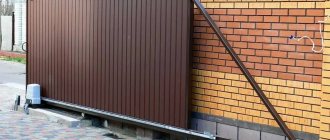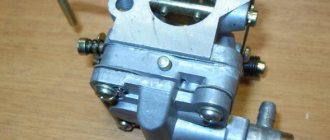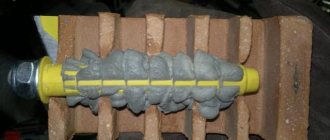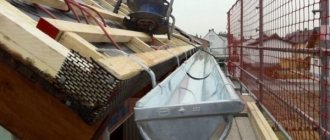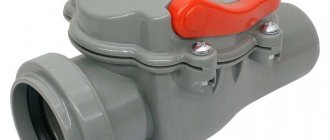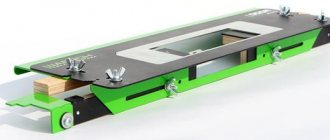The correct installation and adjustment of hidden hinges completely influences the further operation of the door. Therefore, if you decide to install hidden hinges yourself, you need to read this article. Also in it you will find information about what tools are needed to perform all the required actions, and how to adjust the products after installation.
Appearance of a hidden door hinge
What to look for when choosing hidden door hinges
When choosing such products, you should pay attention not only to their cost, but also to their performance characteristics.
It is better to buy fittings from trusted manufacturers such as AGB, Armadillo, Krona Koblenz and others. There is no need to try to save money by buying loops of dubious origin. Door hinges must ensure not only smooth and easy opening of the door, but also reliable fixation to the frame.
The Italian company AGB is a well-known manufacturer of hidden hinges
There are no specific instructions for choosing the right hidden loops. To purchase accessories that meet your requirements, it is enough to determine the following parameters:
- Door opening side. There are right and left loops. You can buy universal models, but their strength is lower.
- Loop size. To do this, you need to decide on the weight of the canvas. If it is 15–25 kg, then hinges 7–8 cm long are sufficient, and when the door weight is 25–40 kg, then canopies 10 cm long must be installed.
- Number of loops. This indicator also depends on the weight of the door leaf. For lightweight structures, it is enough to install two hinges. If the canvas is heavy, then 3-4 canopies will be needed.
- Material. For heavy entrance doors, you need to purchase hinges made of steel or brass. They are more durable, but also expensive. For interior structures, you can use hinges made of tsamak alloy. Their strength is sufficient for reliable fixation of interior paintings, and the cost of such fittings is less than that of steel or brass.
Materials
List of materials needed to make a safe with your own hands.
Made of metal
- Sheet metal, the thickness of which is not less than 2 mm and complies with the parameters established by law, if applicable. Components that ensure the operation of the door: a lock and internal hinges, which are installed as hidden.
- Iron corners 30x30 mm. The size varies depending on the characteristics of the safe as a whole. The number of corners required for welding the frame is determined by the dimensions of the cache.
If items of safety fall into the list of items whose storage is described by law (for example, weapons, medicines), the safe is equipped with two locks of different types.
Made of wood
A wooden safe can be made from plywood of sufficient thickness. It is worth choosing the thickest sheets possible. Plywood is the best material for making a wooden safe because of its ply structure, which provides cross-strength to the wood fibers.
- Bars with dimensional parameters of at least 45x45 mm. They are used to assemble the internal frame and provide the ability to fasten plywood walls from the inside.
- Metal fasteners: corners, plates, hinges, screws. Locking devices.
A wooden safe has the lowest security and burglary resistance. It is used to preserve items of low value.
Fire resistant
This modification of the safe provides for the presence of two-layer walls, between which there is a fire-resistant protective layer. When making such a cache, you will need sheet asbestos (soft) or a heat-resistant cement-sand mixture.
Brief overview of proven manufacturers
It is not realistic to list all the companies operating in our market, so we took only those brands whose products have no complaints or negative reviews.
The company has been operating for about 60 years and has been represented on our market since the mid-nineties. It has a fairly wide range of secret canopies.
- The simplest mechanisms from AGB can withstand a weight of 20 kg, which is quite enough to hang an average interior door;
- Much attention is paid to the color scheme of products; here you will find canopies to suit any interior;
- Absolutely all mechanisms of this brand are adjustable in all 3 directions, and the adjustments are not lost after adjustment.
Armadillo
Fittings from the Armadillo brand are famous for their strength, reliability and decent appearance. It has been present on the domestic market for more than 10 years. Armadillo focuses on the elite category, so you shouldn’t expect a reasonable price.
This brand is especially proud of the use of so-called active bearings. Due to this innovation, the door leaf closes softly and almost silently, with no squeaks to speak of.
If you are interested in hidden hinges with a built-in closer, then Armadillo mechanisms are exactly what you need.
Fastener with bearing
Hinges with bearings are a type of fastener that is in great demand among consumers. Products of this type have a characteristic feature - the design of the product contains a simple bearing (ball), which is placed between two parts of the part. Thanks to the bearing, awnings of this type can be installed on doors with any weight: the element will ensure easy opening/closing of the structure, regardless of the degree of load.
There are two types of bearing fasteners - cylindrical products with a ball and drop-shaped loops for metal structures. The difference between the two types lies in the installation work.
Cylindrical parts are welded onto plates, which provide a functional gap between the fastening element itself and the door leaf. There is no need to weld the teardrop-shaped canopy - the very shape of the element will provide the necessary technological gap.
Mortise models: types and installation
Mortise hinges are similar in appearance to overhead awnings with a card structure. The difference lies in the method of fastening and detachable plates.
Popular types of such loops:
- Brass. They have an aesthetic appearance and are in great demand. There are two types of canopies in the retail chain: chrome-plated and polished.
- Brass plated. They are made from several alloys. To give an aesthetic appearance, brass, bronze and gold plating is used.
- Steel. The most reliable and high-quality type of fastening. They are not subject to grinding, therefore they have a long service life. To preserve the aesthetic appearance of the canvas, they are cut into the end of the door frame. The recess and configuration of the recess corresponds to the thickness and shape of the plates.
Door markings
- Pencil.
- Ruler (long)
Do-it-yourself marking algorithm:
- Determine the opening (left-handed or right-handed).
- Measure 20 cm from the top and bottom of the canvas and make notes.
- Attach the loops to the marks (the top of the plate on the mark), circle, and mark the points for attaching the screws. The rod should not touch the door so that the door opens and closes freely.
- If there are knots or chips at the calculated location, the loop should be placed a couple of centimeters lower.
- Assemble the box.
- Make marks in the same way, maintaining a gap between the box and the canvas (2-3 mm).
- If the canvas is made of solid wood, or weighted, you need to install another loop (a little closer to the top).
Additional accessories
A loop is a simple mechanism that can perform only one function - rotation around a central axis. This is enough to open the hatch, but not enough to use it safely.
Hinges for the basement hatch cover
A hatch in the floor is a potential source of danger. Theoretically, it may not be able to cope with the load and slam shut when a person is in the basement.
If the hatch is heavy, it can tear out the hinges, swing open too wide and damage the wall or furniture behind it. Children can also get inside.
To avoid these troubles, the hinges are supplemented with different units.
| Addition, photo: | Description: |
Electric drive for sunroof | When the hatch door is very heavy, not everyone can lift it. The hinges are supplemented with drives, usually electric. Drive control via buttons and switches or remote control. It costs a lot of money, but it is reliable. The drive also plays the role of a limiter and retainer. |
Gas struts | Gas lifts are shock absorbers and closers that constantly press on the manhole cover from below. They make it easier to open the lid, and when lowering it, they resist movement, which allows you to slam the hatch smoothly, without a strong blow. Important! Any heavy cover should be equipped with this equipment, even when an electric drive is installed that could use some help. Gas lifts are cheap. You need to choose their load capacity and quantity based on the mass of the hatch cover, otherwise they may not be able to cope with the loads. Gas lifts help prevent spontaneous closing of the hatch, but you shouldn’t rely on them alone. |
Step clamps | Such clamps are also installed on heavy metal hatches. When you open the lid, the mechanism clicks open, then receives a reliable stop on the movable jumper, which, due to the built-in mechanism, can be removed when the hatch needs to be closed. |
Screw retainer | The purpose is the same as the previous one, only it works differently. When the hatch is open, the fixing screw with a convenient plastic head is tightened and clamps the guide plate, which is enough to secure the gas lift. |
Hinge for hatch with lock | The store also has hinges with locking mechanisms. Not the most convenient solution, since you have to reach the hinges to fix it. |
To prevent the hatch from being opened by children who, for example, can find the control panel from an electric drive, the lid should be supplemented with a locking mechanism.
Advantages and disadvantages of hidden door hinges
At first, hidden hinges were installed only on entrance doors, this is due to their high burglary resistance. Now many people have begun to install such canopies on interior ones, and they are guided by the following advantages of hidden hinges:
- Attractiveness. Such hinges do not spoil the appearance of the door leaf, so they can be installed on almost all types of doors, including products with an “invisible” frame.
- High reliability. A pair of hidden hinges can support a door leaf weighing 50 kg, while conventional ones are designed for a leaf weight of 30 kg.
- Comfort. They can be adjusted in three directions: vertically, horizontally and clamping. This can be done both during installation and during operation. This adjustment is important for new buildings, since after some time the house may shrink, which is why the doors begin to close poorly. Some models of hidden hinges allow you to open the door 180o.
- Long service life.
- Versatility. Such hinges can be mounted on canvases made of wood and metal, as well as synthetic materials. Most manufacturers include such accessories in their range.
Despite the large number of advantages, hidden hinges also have disadvantages:
- High cost of fittings.
- The risk of deformation of the door frame when trying to suddenly open the doors due to the presence of levers.
- Low strength of the door structure due to the creation of holes in the frame and door leaf for the installation of such hinges.
- The width of the rebate at the entrance door on the hinge side is reduced, so the sealing of the gaps is worse.
- The installation of the platband is difficult, since when the door is opened, the door leaf rests against it.
What tools are needed for the job?
In order not to be distracted by extraneous factors during the work process, it is recommended to immediately prepare the necessary tools, equipment and materials presented below:
- Pencil for marking.
- Ruler or construction tape.
- Screwdriver and set of screws.
- Drill and cutter.
- Building level.
- Hammer and chisel.
After you have prepared all the specified tools and placed them in the work area, you can begin.
Remember that the depth of insertion of hidden hinges is much greater than that when installing conventional hinges. In this regard, it is necessary to select a different cutter attachment for the drill, or use a standard cutter more carefully so as not to damage the door leaf.
A few words about adjustment
There are a number of models that provide the ability to adjust the position of the door leaf in 3 directions.
Adjustment of hidden hinges of interior doors is carried out using a hex key. The location of the adjusting screws for adjusting the position of the leaf is provided in that part of the mechanism that cuts into the door frame:
- adjustment in the horizontal plane is carried out by a screw located on the surface of the element;
- vertical adjustment is carried out with a screw located vertically;
- To ensure the necessary pressure, the adjustment mechanism is an eccentric.
If we are talking about the position of the blade relative to the box, the available stroke is 1 mm up-down, left-right and is done by turning the screw on both hinges at the same time. The depth of the clamp can be changed by tightening 2 eccentrics with a hexagon.

